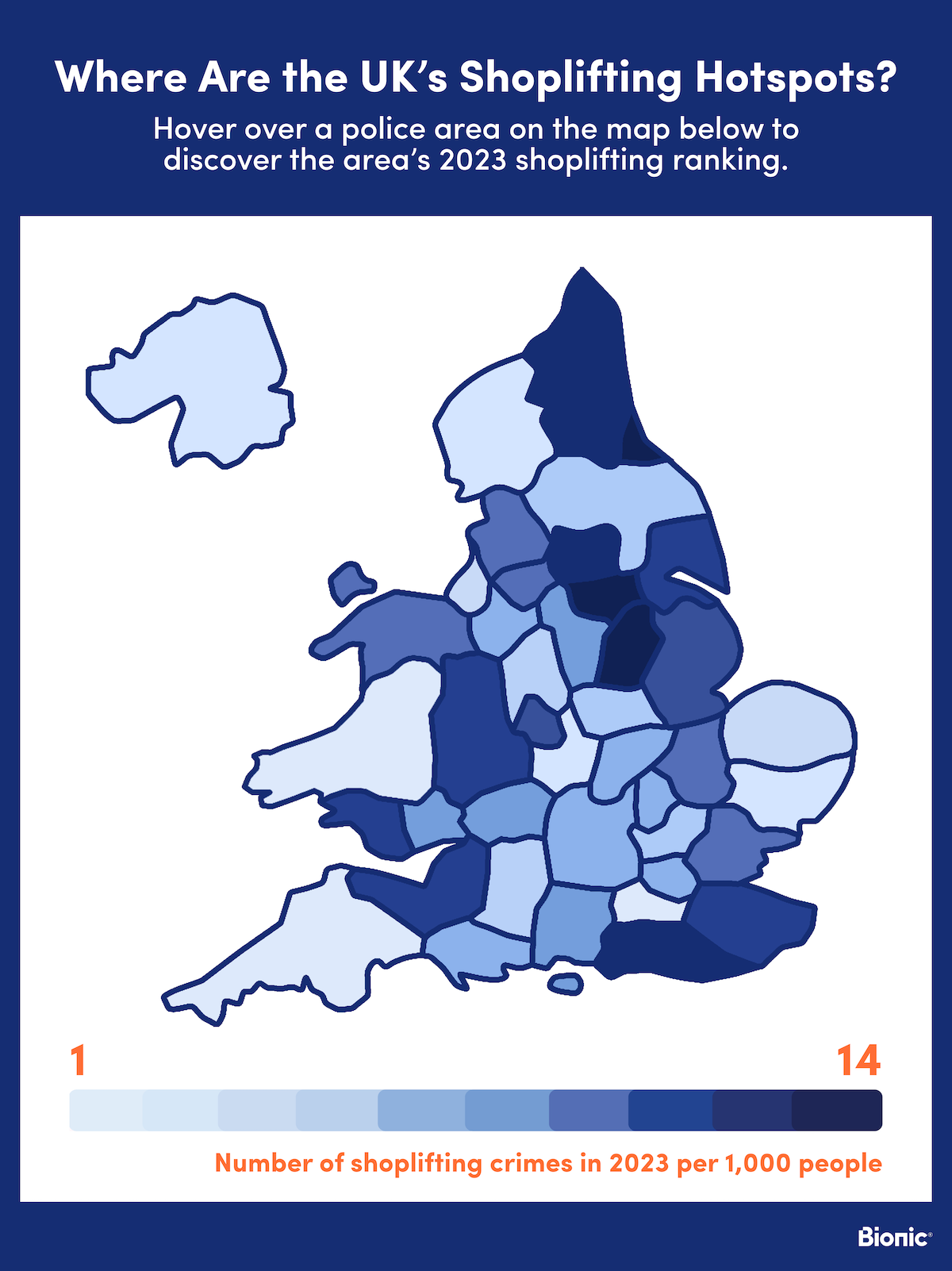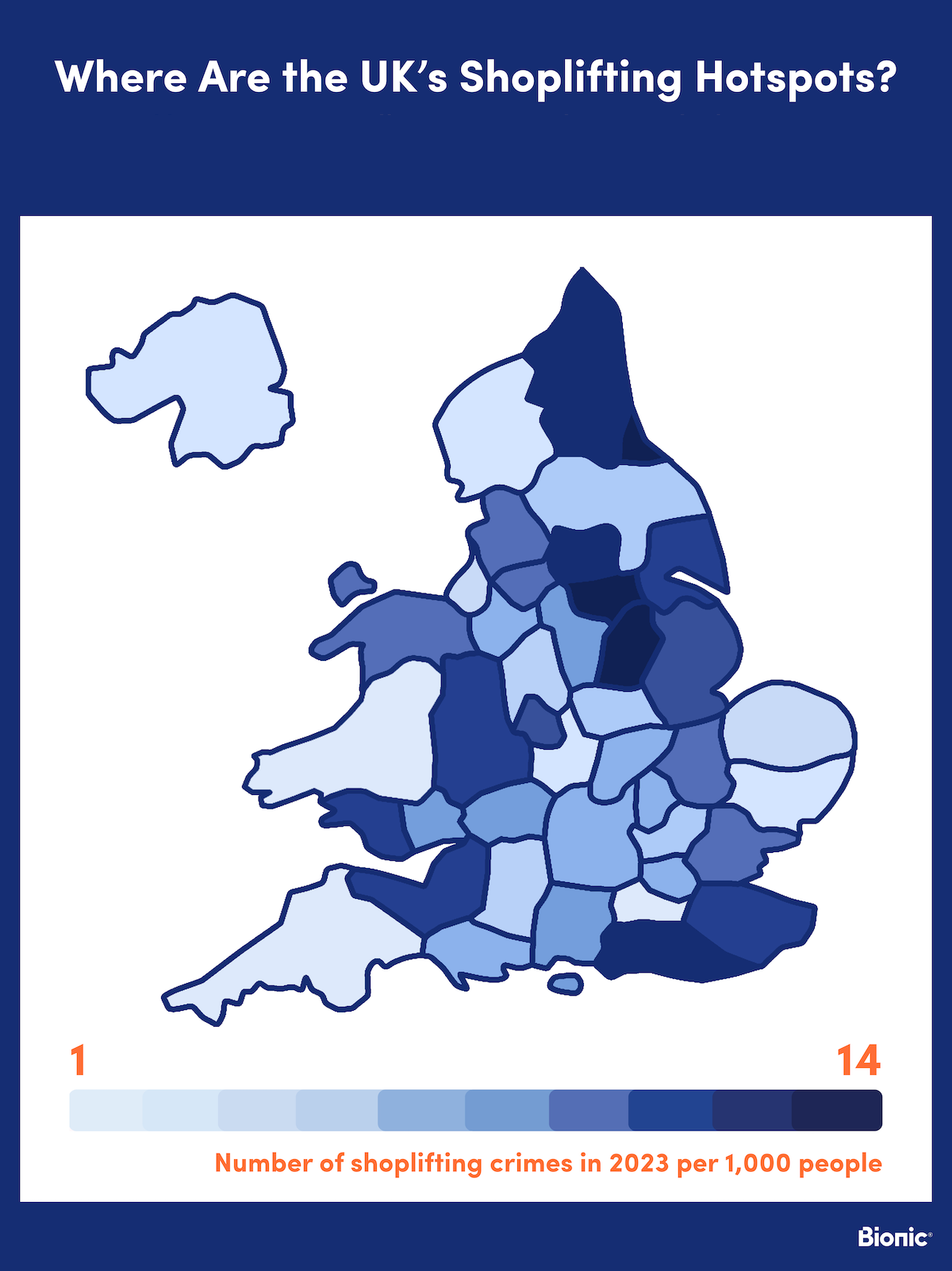The Best & Worst Shoplifting Areas Across the UK
- Shoplifting in the UK has surged by 26% in just a year, with 7.1 crimes per 1,000 people (excluding Scotland).
- Cleveland Police tops the list with a staggering 14 shoplifting crimes per 1,000 people, while Dyfed-Powys Police in Wales sees the lowest rate at just 3.
- In 2023, the Metropolitan Police reported over £15M worth of stolen goods and money from businesses.
- July has the highest rate of shoplifting crimes, during which over 40,000 shoplifting crimes took place.
New data from Bionic reveals the number of reported shoplifting cases spiked in 2023 and highlights some of the biggest hotspots across the UK.
Shoplifting, which refers to the theft of goods from retailers, can have a big financial and operational effect on businesses of all sizes, especially SMEs. 2023 was the worst year on record for shoplifting, with figures from the Office for National Statistics showing an increase in incidents nationwide.
The rise has been coined the ‘shoplifting epidemic’, with industry leaders pointing to the increasing cost of living crisis as a key driver. As financial pressures take their toll, more people turn to theft, leading to record-high incidents.
Data Disclaimer
The City of London Police (the force that covers the central business area of the city) recorded the highest rate of crimes per 1,000 people. But just 8,700 people permanently live in the capital’s main financial district. This relatively small number skewed the data, so this police force was removed from the rankings.
Police Scotland also refused the FOI request due to time constraints, so Scotland’s data has also been removed from this study.
What did the data tell us about shoplifting behaviour in the UK?
Bionic’s latest study digs deep into the data, identifying the UK’s shoplifting hotspots and highlighting the need for businesses to protect themselves.
The data gives a clear outline of shoplifting behaviours across the UK, revealing a big uplift in criminal activity in 2023. A staggering 433,042 shoplifting crimes were logged throughout the year in the UK (excluding Scotland), marking a 26% increase in cases compared to the same period of the previous year. This more than a quarter rise in thefts suggests a concerning trend, with 7.1 shoplifting crimes per 1,000 people, up from 5.7 in 2022, based on shoplifting figures from the ONS.
The financial losses to businesses are huge. In 2023, the Metropolitan Police documented over £15m in stolen goods and money, while West Yorkshire saw over £2 million worth of thefts.
Among all police forces, Cleveland Police experienced the highest rate of shoplifting, with 14 crimes per 1,000 people, while Dyfed-Powys Police in Wales reported the lowest, at just 3 per 1,000.
The UK’s shoplifting hotspots

How does each UK police force rank for shoplifting?
Use this interactive map to see where your local police force ranks.


Dyfed-Powys Police, covering rural areas like Carmarthenshire, Ceredigion, Pembrokeshire, and Powys, reports the lowest shoplifting rate in the UK, with just 3 crimes per 1,000 people. In stark contrast, Cleveland Police has a rate of 14 per 1,000 — nearly five times higher, despite both forces serving similar population sizes.
Surrey Police comes in second lowest in the list with a rate of 4.2 per 1,000 people. Interestingly, neighbouring Kent has more than double the shoplifting rate, ranking 13th out of 44 police forces, with 9 crimes per 1,000 people,
Perhaps surprisingly, the UK’s largest police force, The Met, ranks 19th with 6.4 crimes per 1,000 people, lower than other forces covering major cities like Greater Manchester (17th) and the West Midlands (12th).
As expected, rural areas dominate the list of forces with the lowest shoplifting rates, including Cumbria, Norfolk, Devon & Cornwall, alongside Dyfed-Powys and Surrey.
UK regions ranked by shoplifting rate
| Ranking | Region | No of Crimes | Crimes per 1000 | % Above or below national average |
| 1 | North East | 29,680 | 11.5 | 35% higher |
| 2 | Yorkshire | 49,888 | 9.7 | 24% higher |
| 3 | East Midlands | 38,351 | 8 | 7% higher |
| 4 | Wales | 23,119 | 7.4 | equal to |
| 5 | South East | 64,678 | 7.2 | 3% lower |
| 6 | West Midlands | 41,188 | 7.1 | 4% lower |
| 7 | London | 58,465 | 6.5 | 14% lower |
| 8 | South West | 35,267 | 6.3 | 19% lower |
| 9 | North West | 44,823 | 6.2 | 16% lower |
| 10 | East | 38,785 | 6 | 23% lower |
| 11 | Northern Ireland | 8,798 | 4.6 | 60% lower |
The North East takes the top spot for shoplifting crimes, with a rate of 11.5 per 1,000 people — 35% higher than the national average. Compare that to Northern Ireland, where the figure is just 4.6, a whopping 60% lower than the national average.
When we look at the North-South divide, two northern regions — the North East and Yorkshire — hold the highest crime rates per 1,000 people. Surprisingly, the North West, home to bustling cities like Manchester and Liverpool, only ranks 9th. On the flip side, the East of England boasts the lowest rates in England, while Northern Ireland has the lowest rate of shoplifting overall when looking at England, Wales and Ireland.
In an interesting twist, the affluent region of the South East ranks 5th but still falls 3% below the national average. London lands in 7th place, though it’s worth noting that the city’s data might be skewed by the City of London area's small permanent population compared to its massive daily working population.
Shoplifting crimes per month
| Month | Total Number of Crimes |
| January | 31,559 |
| February | 33,078 |
| March | 36,464 |
| April | 35,228 |
| May | 35,373 |
| June | 35,528 |
| July | 40,038 |
| August | 39,742 |
| September | 37,401 |
| October | 39,335 |
| November | 36,442 |
| December | 32,884 |
Months with the highest shoplifting rates:
- July
- August
- October
Months with the lowest shoplifting rates:
- January
- December
- February
In contrast to what we would have expected to see, shoplifting rates surprisingly don’t peak during the colder months when people are spending more on heating and winter essentials. In fact, the study found that winter, especially the festive period and the first two months of the year, had the lowest shoplifting rate.
July takes the top spot for shoplifting, with 40,038 crimes logged, 27% more than January, which saw the fewest incidents. Interestingly, October, when the clocks go back and the evenings grow darker, ranked as the third worst month for shoplifting.
How much money are small businesses losing to shoplifting?
Disclaimer: Only 12 police forces could supply the value of stolen goods/money. As this isn’t something that’s logged for each shoplifting occurrence, it’s important to remember that these figures do not show a complete picture of stolen goods across the UK.
The Metropolitan Police Force logged £15,556,626 worth of stolen goods and money from businesses in their constituency during 2023. August saw the highest value stolen, with £1,122,184, which could suggest spikes due to the summer holidays. February had the lowest value, with £974,798; it’s clear that retail theft can fluctuate dramatically throughout the year.
On the other hand, West Yorkshire Police logged £2,039,181 worth of stolen goods and money from businesses during 2023. Kent police also logged an eyewatering £1,176,984 worth of stolen goods and money, whilst Northumbria police reported losses exceeding £1.4m.
While these figures already highlight the financial burden shoplifting places on businesses, a recent forecast from Retail Economics projected that the total value of retail theft in 2023 would reach a staggering £7.9 billion across the UK. This shows that small businesses, in particular, could be facing even greater losses than what’s recorded, making it more crucial than ever for them to protect their stock and take preventive measures.
How can small businesses protect themselves from shoplifting?
For small businesses just trying to get by, shoplifting can be a particularly heavy blow. Unlike large retailers with bigger budgets, SMEs often lack the financial flexibility to absorb the costs of stolen goods or invest in better security systems.
Les Roberts, Business Comparison Expert at Bionic says, “Overall, our study highlights a concerning rise in shoplifting across the UK, with small businesses being particularly vulnerable. The recent increase in theft — up by 26% YoY — could be linked to the current economic pressures, as people struggle with the cost of living. This impact can be devasting for SMEs, who don't have the financial resources to invest in expensive security measures and have to rely on options like signage to deter thieves ”
But is there anything you can do to protect your business from shoplifters?
Install security systems
Investing in effective security systems like CCTV cameras, alarms and security tags for high-value items is a crucial first step in protecting your business. CCTV cameras not only serve as a deterrent but also provide valuable evidence if a theft does occur.
Be sure to place cameras strategically around the store, especially near entrances, exits, and tills, where theft is most likely to happen.
Alarms can alert staff when tagged items are taken, and security tags on higher-ticket products help add an extra layer of protection, making it more difficult for shoplifters to leave unnoticed.
Identify high-risk items
Although it seems obvious, you'll want to make sure your most expensive items are within the eyeline of a shop worker. If a thief feels someone is watching them, they'll be less likely to steal.
Similarly, it's best to store high-value items behind your counter so only staff have access to them — this way they're not at risk of being snatched by shoplifters.
Use signs and deterrents
Sometimes, a simple sign can be one of the most effective deterrents. Visible signage, such as “CCTV in operation” or “Shoplifters will be prosecuted,” lets potential thieves know that your business takes security seriously and won’t tolerate theft – these reminders work well at entrance points and high-theft areas.
Additionally, placing mirrors in strategic spots and using dummy cameras in less-critical zones can enhance the perception that your store is closely monitored, even if resources are limited.
Sort your business insurance with Bionic
At Bionic, we value and champion UK businesses. We understand their unique challenges, especially regarding the risks of running a small business, whether a shop, a salon, or anything in between.
Having the right business insurance can help cover the cost of any claims or damages that could otherwise leave you significantly short of money.
It’s important to make sure your insurance policy covers all the risks. If you’re unsure what cover you need, we can help you figure it out. We can talk you through the options, making sure you know all about coverage limits and policy exclusions before you take out cover.
This can help you find the right insurance coverage for the needs of your business so you are sufficiently protected against risks.
Learn more with our business insurance guides, or get in touch today by starting a quote online.
Methodology
This data was collected by contacting the 45 police forces in the UK and requesting the following data through an FOI request:
- The number of shoplifting offences logged by the force between 01/01/2023 and 31/12/2023.
- The value of stock or money that was reported stolen in each shoplifting offence reported between 01/01/2023 and 31/12/2023.
- The ward or postcode of each business involved in a shoplifting offence logged by the force between 01/01/2023 and 31/12/2023.
- The month in which each shoplifting offence logged by the force between 01/01/2023 and 31/12/2023 occurred.
In the instances that the police force could not provide the data, the data was downloaded from Police.uk data (a database of crimes in each UK police force) source: https://data.police.uk/data/
As aforementioned, only 13 police forces were able to share data related to point 2 regarding the value of stock or money that was reported stolen in each shoplifting offence reported between 01/01/2023 and 31/12/2023. This was because this data is not collected in every instance of a shoplifting offence.
Police Scotland also refused the FOI request due to time constraints. Shoplifting data for the latter half of 2023 is not yet available in the public domain, which is why Scotland's data has been omitted from this study.
The population of people that each police force serves was also collected from the force’s website and once the FOI data was retrieved, the number of logged shoplifting occurrences was divided by the population then multiplied by 1000. The resulting figure was the number of shoplifting crimes per 1000 people in the population.
The UK police forces were then ranked by the highest number of shoplifting crimes per 1000 people of the population to lowest to determine the UK’s shoplifting hotspots.
The best and worst months for shoplifting crimes were established by investigating the months with the highest and lowest number of crimes for each police force.








